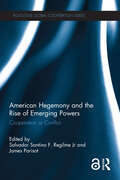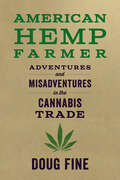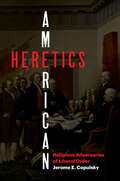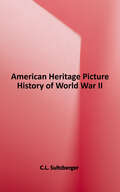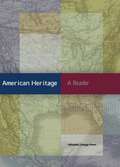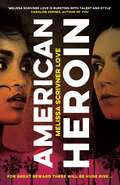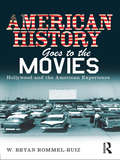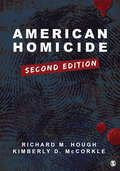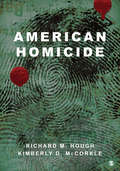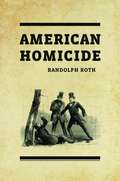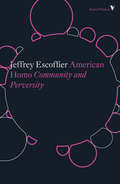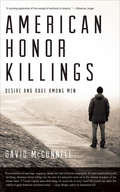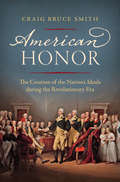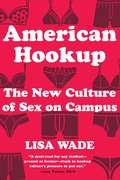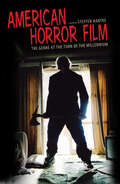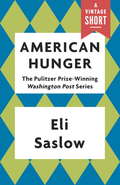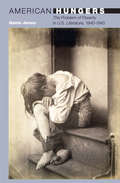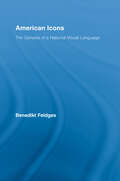- Table View
- List View
American Hegemony and the Rise of Emerging Powers: Cooperation or Conflict (ISSN)
by James Parisot Salvador Santino F. RegilmeOver the last decade, the United States' position as the world's most powerful state has appeared increasingly unstable. The US invasions of Afghanistan and Iraq, non-traditional security threats, global economic instability, the apparent spread of authoritarianism and illiberal politics, together with the rise of emerging powers from the Global South have led many to predict the end of Western dominance on the global stage. This book brings together scholars from international relations, economics, history, sociology and area studies to debate the future of US leadership in the international system. The book analyses the past, present and future of US hegemony in key regions in the Asia-Pacific, Latin America, Middle East, Europe and Africa – while also examining the dynamic interactions of US hegemony with other established, rising and re-emerging powers such as Russia, China, Japan, India, Turkey and South Africa.American Hegemony and the Rise of Emerging Powers explores how changes in the patterns of cooperation and conflict among states, regional actors and transnational non-state actors have affected the rise of emerging global powers and the suggested decline of US leadership. Scholars, students and policy practitioners who are interested in the future of the US-led international system, the rise of emerging powers from the Global South and related global policy challenges will find this multidisciplinary volume an invaluable guide to the shifting position of American hegemony.The Open Access version of this book, available at http://www.taylorfrancis.com, has been made available under a Creative Commons Attribution-Non Commercial-No Derivatives (CC-BY-ND) 4.0 license.
American Hemp Farmer: Adventures and Misadventures in the Cannabis Trade
by Doug FineThe inside story of the world&’s most fascinating and lucrative crop from gonzo journalist–turned–hemp farmer Doug Fine.Hemp, the non-psychoactive variant of cannabis (or marijuana) and one of humanity&’s oldest plant allies, has quietly become the fastest industry ever to generate a billion dollars of annual revenue in North America. From hemp seed to hemp fiber to the currently ubiquitous cannabinoid CBD, this resilient crop is leading the way toward a new, regenerative economy that contributes to soil and climate restoration—but only if we do it right.In American Hemp Farmer, maverick journalist and solar-powered goat herder Doug Fine gets his hands dirty with healthy soil and sticky with terpenes growing his own crop and creating his own hemp products. Fine shares his adventures and misadventures as an independent, regenerative farmer and entrepreneur, all while laying out a vision for how hemp can help right the wrongs of twentieth-century agriculture, and how you can be a part of it.
American Heretics: Religious Adversaries of Liberal Order
by Jerome E. CopulskyA penetrating account of the religious critics of American liberalism, pluralism, and democracy—from the Revolution until today &“A chilling consideration of persistent mutations of American thought still threatening our pluralist democracy.&”—Kirkus Reviews (starred review) The conversation about the proper role of religion in American public life often revolves around what kind of polity the Founders of the United States envisioned. Advocates of a &“Christian America&” claim that the Framers intended a nation whose political values and institutions were shaped by Christianity; secularists argue that they designed an enlightened republic where church and state were kept separate. Both sides appeal to the Founding to justify their beliefs about the kind of nation the United States was meant to be or should become. In this book, Jerome E. Copulsky complicates this ongoing public argument by examining a collection of thinkers who, on religious grounds, considered the nation&’s political ideas illegitimate, its institutions flawed, and its church‑state arrangement defective. Beholden to visions of cosmic order and social hierarchy, rejecting the increasing pluralism and secularism of American society, they predicted the collapse of an unrighteous nation and the emergence of a new Christian commonwealth in its stead. By engaging their challenges and interpreting their visions we can better appreciate the perennial temptations of religious illiberalism—as well as the virtues and fragilities of America&’s liberal democracy.
American Heritage Picture History of World War II
by C.L. Sultzberger and the Editors of American HeritageEye-witness accounts augment a pictorial history of World War II at both the battlefronts and at home.
American Heritage: A Reader
by The Hillsdale College History FacultyToo many colleges and universities have become places for focusing on means and not upon ends--and, as such, places where the confused and bewildered of the next generation acquire techniques and tools, but graduate having gained neither direction nor order to their souls. The Hillsdale College History Faculty has painstakingly assembled American Heritage: A Reader in order to provide its own students with a true liberal arts education grounded in the American tradition. Perfect for classroom use at the high school level and up, this extraordinary textbook will provide readers both inside and outside the classroom with a traditional educational experience that enlarges and ennobles the mind. From the Preface: "The primary role of this Reader is to supply a rich sample of documents from the periods we examine. These primary sources provide portals into the American past. Reading them, we escape the provincialism of our own time and culture. As artifacts of the past, they do not convey information merely, but they are the sources that historians interpret to make sense of our past. Consequently, we invite students to engage in the same enterprise as they examine these fragments of the American past as the primary means of understanding both the roots of American order and sources for contemporary disorders. This daunting task of viewing sympathetically ideas that, although part of our heritage, seem distant and alien is an important and exhilarating part of a proper education in which one seeks to make sense of oneself as an American. "
American Heroin: 'A rip-through-it-in-one-sitting thrill ride that will leave readers hooked' Joseph Knox (The\lola Vasquez Novels Ser. #2)
by Melissa Scrivner LoveAmerican Heroin is the eagerly-awaited sequel to Lola, featuring a ruthless woman who will stop at nothing to protect her growing drug empire It took sacrifice, pain, and more than a few dead bodies, but Lola has clawed her way to the top of her South Central Los Angeles neighborhood. Her gang has grown beyond a few trusted soldiers into a full-fledged empire, and the influx of cash has opened up a world that she has never known. But with great opportunity comes great risk, and as Lola ascends the hierarchy of the city&’s underworld she attracts the attention of a dangerous new cartel who sees her as their greatest obstacle to dominance. Soon Lola finds herself sucked into a deadly all-out drug war that threatens to destroy everything she&’s built. But even as Lola readies to go to war, she learns that the greatest threat may not be a rival drug lord but a danger far closer to home: her own brother. Edgy, complex, and breathtakingly propulsive, Melissa Scrivner Love has crafted a novel sure to please not only those who loved her first book but everyone who enjoys a gripping thriller.
American Hippies (Cambridge Essential Histories)
by Donald CritchlowIn the late 1960s and early 1970s hundreds of thousands of white middle-class American youths suddenly became hippies. This short overview of the hippie social movement in the United States examines the movement's beliefs and practices, including psychedelic drugs, casual sex, and rock music, as well as the phenomena of spiritual seeking, hostility to politics, and communes. W. J. Rorabaugh synthesizes how hippies strived for authenticity, expressed individualism, and yearned for community. Viewing the tumultuous Sixties from a new angle, Rorabaugh shows how the counterculture led to subsequent social and cultural changes in the United States with legacies including casual sex, natural foods, and even the personal computer. The first short but comprehensive overview to examine the hippie movement in the United States during the late 1960s and early 1970s Describes who became a hippie, what hippies thought, and how they behaved, including their politics Explains why hippies emerged when they did
American History
by Michael B. Stoff James West Davidson Jennifer L. BertoletIn 'They Say,' James West Davidson recounts the first thirty years in the passionate life of Ida B. Wells--as well as the story of the great struggle over the meaning of race in post-emancipation America. Davidson captures the breathtaking and often chaotic changes that swept the South as Wells grew up in Holly Springs, Mississippi: the spread of education among free blacks, the rise of political activism, and the bitter struggles for equality in the face of entrenched social custom. When Wells came of age she moved to bustling Memphis, where her quest for personal fulfillment was thwarted as whites increasingly used race as a barrier to separate blacks from mainstream America. Davidson traces the crosscurrents of these cultural conflicts through Wells's forceful personality, intertwining her struggle to define herself with her early courageous, and often audacious, behavior. When a conductor threw her off a train for refusing to sit in the segregated car, she sued the railroad--and won. When she protested conditions in segregated Memphis schools, she was fired--and took up journalism. And in 1892, when an explosive lynching rocked Memphis, Wells embarked fully on the career for which she is now remembered, as outspoken anti-lynching writer and lecturer. Period photographs from postcards, newspapers, and Wells's own diary further engage readers in this dynamic story. Richly researched and deftly written, the book offers a gripping portrait of the young Ida B. Wells, who directly encountered and influenced the evolving significance of race in America.
American History Goes to the Movies: Hollywood and the American Experience
by W. Bryan Rommel RuizWhether they prefer blockbusters, historical dramas, or documentaries, people learn much of what they know about history from the movies. In American History Goes to the Movies, W. Bryan Rommel-Ruiz shows how popular representations of historic events shape the way audiences understand the history of the United States, including American representations of race and gender, and stories of immigration, especially the familiar narrative of the American Dream. Using films from many different genres, American History Goes to the Movies draws together movies that depict the Civil War, the Wild West, the assassination of JFK, and the events of 9/11, from The Birth of a Nation and Gone with the Wind to The Exorcist and United 93, to show how viewers use movies to make sense of the past, addressing not only how we render history for popular enjoyment, but also how Hollywood’s renderings of America influence the way Americans see themselves and how they make sense of the world.
American Homelessness: A Reference Handbook (3rd edition)
by Mary Ellen HombsHombs (of the Massachusetts Housing and Shelter Alliance) offers a collection of reference materials that provide information on the pervasive problem of homelessness in the United States. Nine chapters offer a chronology of the homeless problem, brief biographical sketches of 20 people who have had an effect on homeless policy and research, statistical information, documents and government reports, legislation from the U.S. and Europe written to address the problem, a list of print and nonprint resources, and a directory of organizations and government agencies. Also included is a brief analysis and discussion of the problem, comparing Europe and the United States.
American Homicide
by Richard M. Hough Kimberly D. McCorkleAmerican Homicide examines all types of homicide, and gives additional attention to the more prevalent types of murder and suspicious deaths in the United States. Authors Richard M. Hough and Kimberly D. McCorkle employ more than 30 years of academic and practitioner experience to help explain why and how people kill and how society reacts. This brief, yet comprehensive book takes a balanced approach, combining scholarly research and theory with compelling details about recent cases and coverage of current trends. Comparative coverage of homicide types and rates in countries around the world shows how American homicide statistics compare internationally.
American Homicide
by Richard M. Hough Kimberly D. McCorkleAmerican Homicide examines all types of homicide, and gives additional attention to the more prevalent types of murder and suspicious deaths in the United States. Authors Richard M. Hough and Kimberly D. McCorkle employ more than 30 years of academic and practitioner experience to help explain why and how people kill and how society reacts. This brief, yet comprehensive book takes a balanced approach, combining scholarly research and theory with compelling details about recent cases and coverage of current trends. Comparative coverage of homicide types and rates in countries around the world shows how American homicide statistics compare internationally.
American Homicide
by Richard M. Hough Professor Kimberly D. McCorkleAmerican Homicide examines all types of homicide, and gives additional attention to the more prevalent types of murder and suspicious deaths in the United States. Authors Richard M. Hough and Kimberly D. McCorkle employ more than 30 years of academic and practitioner experience to help explain why and how people kill and how society reacts. This compressive text takes a balanced approach combining scholarly research and theory with compelling details about recent cases and coverage of current trends.
American Homicide
by Richard M. Hough Professor Kimberly D. McCorkleAmerican Homicide examines all types of homicide, and gives additional attention to the more prevalent types of murder and suspicious deaths in the United States. Authors Richard M. Hough and Kimberly D. McCorkle employ more than 30 years of academic and practitioner experience to help explain why and how people kill and how society reacts. This compressive text takes a balanced approach combining scholarly research and theory with compelling details about recent cases and coverage of current trends.
American Homicide
by Randolph RothIn American Homicide, Randolph Roth charts changes in the character and incidence of homicide in the U.S. from colonial times to the present. Roth argues that the United States is distinctive in its level of violence among unrelated adults—friends, acquaintances, and strangers. America was extraordinarily homicidal in the mid-seventeenth century, but it became relatively non-homicidal by the mid-eighteenth century, even in the slave South; and by the early nineteenth century, rates in the North and the mountain South were extremely low. But the homicide rate rose substantially among unrelated adults in the slave South after the American Revolution; and it skyrocketed across the United States from the late 1840s through the mid-1870s, while rates in most other Western nations held steady or fell. That surge—and all subsequent increases in the homicide rate—correlated closely with four distinct phenomena: political instability; a loss of government legitimacy; a loss of fellow-feeling among members of society caused by racial, religious, or political antagonism; and a loss of faith in the social hierarchy. Those four factors, Roth argues, best explain why homicide rates have gone up and down in the United States and in other Western nations over the past four centuries, and why the United States is today the most homicidal affluent nation.
American Homo: Community and Perversity
by Jeffrey EscoffierA sweeping account of the way lesbian, gay, and bisexual people have challenged and changed societyIn this provocative book, Jeffrey Escoffier tracks LGBT movements across the contested terrain of American political life, where they have endured the historical tension between the homoeroticism coursing through American culture and the virulent periodic outbreaks of homophobic populism. Escoffier explores how every new success enables a new disciplinary and normalizing form of domination; only the active exercise of democratic rights and participation in radical coalitions allows LGBT people to sustain the benefits of community and the freedom of sexual perversity.
American Honor Killings: Desire and Rage Among Men
by David McconnellIN AMERICAN HONOR KILLINGS, straight and gay guys cross paths, and the result is murder. But what really happened? What role did hatred play? What about bullying and abuse? What were the men involved really like, and what was going on between them when the murder occurred? This book explores the truth behind squeamish reporting and uninformed political rants of the far right or fringe left. David McConnell, a New York-based novelist, researched cases from small-town Alabama to San Quentin's death row. The book recounts some of the most notorious crimes of our era.<P> BEGINNING IN 1999 and lasting until last year's conviction of a youth in Queens, New York, the book shows how some murderers think they're cleaning up society. Surprisingly, other killings feel almost preordained, not a matter of the victim's personality or actions so much as a twisted display of a young man's will to compete or dominate. We want to think these stories involve simple sexual conflict, either the killer's internal struggle over his own identity or a fatally miscalculated proposition. They're almost never that simple.<P> TOGETHER, THE CASES FORM A SECRET AMERICAN HISTORY of rage and desire. McConnell cuts through cant and political special pleading to turn these cases into enduring literature. In each story, victims, murderers, friends, and relatives come breathtakingly alive. The result is more soulful, more sensitive, more artful than the sort of "true crime" writing the book was modeled on. A wealth of new detail has been woven into old cases, while new cases are plumbed for the first time. The resulting stories play out exactly as they happened, an inexorable sequence of events--grisly, touching, disturbing, sometimes even with moments of levity.
American Honor: The Creation of the Nation's Ideals during the Revolutionary Era
by Craig Bruce SmithThe American Revolution was not only a revolution for liberty and freedom, it was also a revolution of ethics, reshaping what colonial Americans understood as "honor" and "virtue." As Craig Bruce Smith demonstrates, these concepts were crucial aspects of Revolutionary Americans' ideological break from Europe and shared by all ranks of society. Focusing his study primarily on prominent Americans who came of age before and during the Revolution—notably John Adams, Benjamin Franklin, Thomas Jefferson, and George Washington—Smith shows how a colonial ethical transformation caused and became inseparable from the American Revolution, creating an ethical ideology that still remains.By also interweaving individuals and groups that have historically been excluded from the discussion of honor—such as female thinkers, women patriots, slaves, and free African Americans—Smith makes a broad and significant argument about how the Revolutionary era witnessed a fundamental shift in ethical ideas. This thoughtful work sheds new light on a forgotten cause of the Revolution and on the ideological foundation of the United States.
American Hookup: The New Culture of Sex on Campus
by Lisa WadeA revelatory account of the new culture of sex that has come to dominate the American college experience. The hookup is now part of college life. Yet the drunken encounter we always hear about tells only a fraction of the story. Rising above misinformation and moralizing, Lisa Wade offers the definitive account of this new sexual culture and demonstrates that the truth is both more heartening and more harrowing than we thought. Offering invaluable insights for parents, educators, and students, Wade situates hookup culture within the history of sexuality, the evolution of higher education, and the unfinished feminist revolution. Using new research, she maps out a punishing emotional landscape marked by unequal pleasures, competition for status, and sexual violence. She discovers that the most privileged students tend to like hookup culture the most, and she considers its effects on racial and sexual minorities, students who “opt out,” and those who participate ambivalently. Accessible and open-minded, compassionate and brutally honest, American Hookup explains where we are and how we got here, asking not “How do we go back?” but “Where do we go from here?”
American Horror Film: The Genre at the Turn of the Millennium
by Steffen HantkeCreatively spent and politically irrelevant, the American horror film is a mere ghost of its former self—or so goes the old saw from fans and scholars alike. Taking on this undeserved reputation, the contributors to this collection provide a comprehensive look at a decade of cinematic production, covering a wide variety of material from the last ten years with a clear critical eye. Individual essays profile the work of up-and-coming director Alexandre Aja and reassess William Malone’s much-maligned Feardotcom in the light of the torture debate at the end of President George W. Bush’s administration. Other essays look at the economic, social, and formal aspects of the genre; the globalization of the US film industry; the alleged escalation of cinematic violence; and the massive commercial popularity of the remake. Some essays examine specific subgenres—from the teenage horror flick to the serial killer film and the spiritual horror film—as well as the continuing relevance of classic directors such as George A. Romero, David Cronenberg, John Landis, and Stuart Gordon. Essays deliberate on the marketing of nostalgia and its concomitant aesthetic and on the curiously schizophrenic perspective of fans who happen to be scholars as well. Taken together, the contributors to this collection make a compelling case that American horror cinema is as vital, creative, and thought-provoking as it ever was.
American Hunger
by Eli SaslowAn eBook short.Winner of the Pulitzer Prize for Explanatory ReportingIn this Pulitzer Prize-winning collection, Washington Post reporter Eli Saslow traveled across the country over the course of a year--from Florida and Texas to Rhode Island and Tennessee--to examine the personal and political implications and repercussions of America's growing food stamp program. Saslow shows us the extraordinary impact the arrival of food stamps has each month on a small town's struggling economy, the difficult choices our representatives face in implementing this $78-billion program affecting millions of Americans, and the challenges American families, senior citizens, and children encounter every day in ensuring they have enough, and sometimes even anything to eat. These unsettling and eye-opening stories make for required reading, providing nuance and understanding to the complex matters of American poverty.
American Hungers: The Problem of Poverty in U.S. Literature, 1840-1945 (20/21 #9)
by Gavin JonesSocial anxiety about poverty surfaces with startling frequency in American literature. Yet, as Gavin Jones argues, poverty has been denied its due as a critical and ideological framework in its own right, despite recent interest in representations of the lower classes and the marginalized. These insights lay the groundwork for American Hungers, in which Jones uncovers a complex and controversial discourse on the poor that stretches from the antebellum era through the Depression. Reading writers such as Herman Melville, Theodore Dreiser, Edith Wharton, James Agee, and Richard Wright in their historical contexts, Jones explores why they succeeded where literary critics have fallen short. These authors acknowledged a poverty that was as aesthetically and culturally significant as it was socially and materially real. They confronted the ideological dilemmas of approaching poverty while giving language to the marginalized poor--the beggars, tramps, sharecroppers, and factory workers who form a persistent segment of American society. Far from peripheral, poverty emerges at the center of national debates about social justice, citizenship, and minority identity. And literature becomes a crucial tool to understand an economic and cultural condition that is at once urgent and elusive because it cuts across the categories of race, gender, and class by which we conventionally understand social difference. Combining social theory with literary analysis, American Hungers masterfully brings poverty into the mainstream critical idiom.
American Icons: The Genesis of a National Visual Language (Routledge Research in Cultural and Media Studies)
by Benedikt FeldgesDespite the work that has been done on the power of visual communication in general, and about the social influence of television in particular, television’s relationship with reality is still something of a black box. Even today, the convention that the screen functions as a window on reality structures much of the production and reception of televisual narratives. But as reality ought to become history at one point, what are we to do with such windows on the past? Developing and applying a highly innovative approach to the modern picture, American Icons sets out to expose the historicity of icons, to reframe the history of the screen and to dissect the visual core of a medium that is still so poorly understood. Dismantling the aura of apparently timeless icons and past spectacles with their seductive power to attract the eye, this book offers new ways of seeing the mechanisms at work in our modern pictorial culture.
American Identity and the Politics of Multiculturalism
by David O. Sears Jack CitrinThe civil rights movement and immigration reform transformed American politics in the mid-1960s. Demographic diversity and identity politics raised the challenge of e pluribus unum anew, and multiculturalism emerged as a new ideological response to this dilemma. This book uses national public opinion data and public opinion data from Los Angeles to compare ethnic differences in patriotism and ethnic identity and ethnic differences in support for multicultural norms and group-conscious policies. The authors find evidence of strong patriotism among all groups and the classic pattern of assimilation among the new wave of immigrants. They argue that there is a consensus in rejecting harder forms of multiculturalism that insist on group rights but also a widespread acceptance of softer forms that are tolerant of cultural differences and do not challenge norms, such as by insisting on the primacy of English.
